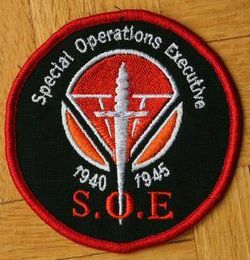SOE
 | |
| Abbreviation | SOE |
| Formation | 22 July 1940 |
| Extinction | 15 January 1946 |
| Headquarters | 64 Baker Street, London |
| Leader | CD of The Special Operations Executive |
| Subgroups | • Special Operations Executive/SO.1 • Special Operations Executive/SO.2 • Special Operations Executive/SO.3 |
| Staff | 13,000 |
| Interest of | Hugh Seton-Watson |
| Subpage | •SOE/CD •SOE/CEO •SOE/SO.1 •SOE/Vice Chief |
The Special Operations Executive (SOE) was a British agency operating during the Second World War, with responsibility for 'special operations' including psychological warfare, assassinations and paramilitary activities.[1]
Origins
After some weeks of discussion among ministers and senior officials of the Foreign Office, War Office, Ministry of Economic Warfare and SIS, the SOE was established in in July 1940 by the amalgamation of three existing organisations:
- Section D of MI6, led by Major Laurence Grand of the Royal Engineers,
- MI R, a think tank of the Military Intelligence Directorate of the War Office, led by Major J.C.F. (‘Joe’) Holland
- Electra House (EH), the secret propaganda arm of the Foreign Office, formed by Sir Campbell Stuart after the Munich crisis[2][3]
Hugh Dalton the Minister of Economic Warfare lead development of the group, choosing Gladwyn Jebb, a senior Foreign Office official who became the architect and exponent of SOE’s official policy and structure. Dalton sacked Laurence Grand, the head of Section D, replacing him as chief of the sabotage component of SOE by Sir Frank Nelson, a former Conservative MP who had been the MI6 representative in Basle, which ensured the initial support of the Chief of SIS. The team, building on a nucleus of the most effective Section D Officers, recruited staff from industrial, commercial and city firms with experience of doing business in foreign countries. Nelson, for example, appointed Sir Charles Hambro, the banker with strong Scandinavian connections, as his Deputy.[3]
Structure
The leader of the SOE was referred to as "CD". Initially, SOE had three sections:
- SO.1 for propaganda, (separated a year later to become the Political Warfare Executive under Rex Leeper and Robert Bruce Lockhart)[4]
- SO.2 for dirty tricks, and
- SO.3 for planning.
Closure
The SOE was closed down in 1946 after a continued rivalry with MI6. The WW2 head of that organisation , Sir Stewart Menzies was a friend of Winston Churchill and "a master at using his political and social connections to win time and eventual survival for SIS, indeed so successful was he that in 1946 he persuaded the Labour Government to close down SOE and transfer its best staff and most promising operations to SIS."[5] MI6's 1946 false flag bombing Operation Embarrass used a team of ex-SOE agents.[6]
Resources
- 64 Baker Street Website on 'The Women of the Special Operations Executive', accessed 30 March 2009.
- Spartacus Educational Special Operations Executive, accessed 30 March 2009
- Obituaries, Special Operations Executive, The Times
- National Archives Special Operations Executive Records Release 8th Feb 2002 (pdf)
Employees on Wikispooks
| Employee | Job | Appointed | End | Description |
|---|---|---|---|---|
| A.J. Ayer | Spook | 1943 | 1945 | |
| John Beevor | Leader for Portugal | 1941 | 1942 | |
| Norman Darbyshire | Intelligence Operative | 1943 | 1946 | |
| Hugh Fraser | Soldier | 1942 | 1945 | |
| Francis Brooks Richards | Director of Operations | World War II | ||
| Monty Woodhouse | Soldier | 1941 | 1945 |
References
- ↑ Stephen Dorril, MI6, Touchstone 2002, p.103.
- ↑ Thomas E. Mahl, Desperate Deception: British Covert Operations in the United States 1939-44, Brassey's, 1999, p.13.
- ↑ a b http://www.sfclub.org/history.htm
- ↑ Thomas E. Mahl, Desperate Deception: British Covert Operations in the United States 1939-44, Brassey's, 1999, p.13
- ↑ The Mechanisms of an Oppressive State
- ↑ http://www.thedailybeast.com/articles/2010/09/19/mi6-attacked-jewish-refugee-ships-after-wwii.html